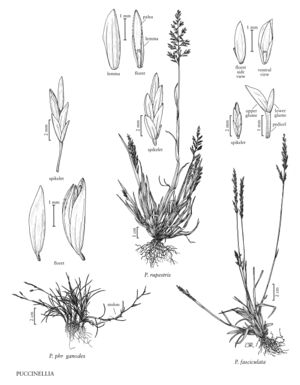Puccinellia phryganodes
Plants perennial; stoloniferous, often forming extensive low mats. Culms 2-15 cm, erect or decumbent. Ligules 0.4-1.5 mm, acute, obtuse, or truncate, entire; blades 0.4-2.2 mm wide when flat, 0.2-1 mm in diameter when involute. Panicles usually not developed, if developed, 1-7 cm, diffuse, lower branches ascending, spikelets usually confined to the distal 1/3; pedicels scabrous, usually with tumid epidermal-cells. Spikelets 6-9 mm, with 3-6 (7) florets. Glumes rounded or slightly keeled over the back, veins obscure or distinct, apices acute or obtuse; lower glumes 1.5-2.2 mm; upper glumes 2.3-2.8 mm; calluses glabrous or almost so; lemmas 3.2-3.8 (4.5) mm, membranous, usually glabrous, occasionally sparsely hairy, backs rounded, 5-veined, veins obscure, not extending to the margins, apices acute or rounded, apical margins whitish, hyaline, smooth, entire; palea veins glabrous; anthers (1.5) 2-2.5 mm, aimost always indehiscent, mature pollen rarely produced. Caryopses rarely developed. 2n = 21, 28.
Distribution
Alaska, Greenland, Man., N.B., Nfld. and Labr., N.W.T., Nunavut, Ont., Que., Yukon
Discussion
Puccinellia phryganodes is a widespread and common circumpolar arctic species that grows on seashores at or near the high tide line, in wet saline meadows, and in saline or brackish marshes.
Selected References
None.
Lower Taxa
"decumbent" is not a number.
